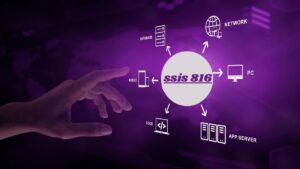In today’s fast-paced digital landscape, efficient data management and integration have become essential for businesses to stay competitive. SQL Server Integration Services (SSIS) 816 stands as a robust solution designed to streamline data workflows, automate processes, and enhance overall efficiency. Let’s delve into what is all about and why it’s gaining traction among enterprises worldwide.
Introduction to SSIS 816
SSIS 816, also known as SQL Server Integration Services, is a comprehensive platform developed by Microsoft for building enterprise-level data integration and workflow solutions. It provides a rich set of features and tools to facilitate the extraction, transformation, and loading (ETL) of data from various sources into target destinations.
ssis 816 History and Background
SSIS has evolved over the years, starting from its inception as part of Microsoft SQL Server 2005. Since then, it has undergone several updates and enhancements to keep pace with evolving business requirements and technological advancements. represents the latest iteration, incorporating cutting-edge features and improvements.
What is SSIS 816?
SSIS 816, the newest iteration of SQL Server Integration Services, empowers businesses with streamlined data management. With , you can easily integrate data from various sources, transform it into the desired format, and load it into your target system.
Why is SSIS 816 important?
In today’s data-driven world, organizations need to be able to manage their data effectively. it provides a powerful tool for doing just that. It allows organizations to integrate data from various sources, transform it into the desired format, and load it into their target system. Turns data into wisdom, fuels operational excellence, and unlocks sustainable competitive advantage
How does SSIS 816 help organizations?
SSIS 816 provides several benefits to organizations, including:
- Improved data quality: it includes new features for data cleansing and validation, which can help improve the quality of your data.
- Increased efficiency: 816 is designed to be faster and more efficient than previous versions of SSIS, which can help organizations save time and money.
- Improved scalability: 816 can handle larger volumes of data than previous versions of SSIS, which can help organizations manage their data more effectively.
- Improved security: 816 includes new security features to help protect your data.
Features and Capabilities
Data Integration
One of the primary functions is data integration, allowing users to consolidate information from disparate sources such as databases, files, and applications. Its intuitive interface enables the creation of complex data pipelines with ease, facilitating seamless connectivity and transformation.
Workflow Automation
SSIS 816 empowers organizations to automate repetitive tasks and workflows, reducing manual intervention and minimizing the risk of errors. By scheduling jobs and defining dependencies, users can orchestrate data processes efficiently, ensuring timely and accurate execution.
Connectivity Options
With support for a wide range of data sources and protocols, SSIS offers unparalleled connectivity options. Whether it’s connecting to cloud-based platforms, legacy systems, or emerging technologies, users can leverage SSIS to bridge disparate data environments seamlessly.
Advantages of SSIS 816

Efficiency and Performance
One of the key advantages of its exceptional performance and efficiency. Through optimized data processing algorithms and parallel execution capabilities, it can handle large volumes of data rapidly, enabling real-time insights and decision-making.
Scalability
It is designed to scale effortlessly to meet the evolving needs of businesses, whether they’re handling small-scale projects or enterprise-wide initiatives. Its modular architecture and distributed processing capabilities ensure scalability without compromising performance.
Flexibility
Another notable advantage of SSIS is its flexibility, allowing users to tailor data integration workflows to suit specific requirements. With support for custom scripts, extensions, and third-party integrations, organizations can adapt SSIS to their unique use cases seamlessly.
Use Cases
SSIS 816 finds application across various industries and scenarios, including:
E-commerce Platforms
For e-commerce businesses dealing with large volumes of transactional data, SSIS offers a reliable solution for extracting, transforming, and loading data into their analytics platforms, enabling insights-driven decision-making and personalized customer experiences.
Data Warehousing
In the realm of data warehousing, SSIS plays a crucial role in consolidating data from multiple sources into a centralized repository, ensuring consistency, accuracy, and accessibility for reporting and analysis purposes.
Business Intelligence
For organizations seeking to derive actionable insights from their data assets, serves as a cornerstone of their business intelligence infrastructure, facilitating the integration of data from diverse sources and the delivery of timely, relevant insights to stakeholders.
How to Get Started with SSIS 816

Installation and Setup
Getting started with SSIS is straightforward, with Microsoft providing comprehensive documentation and resources for installation and setup. Users can choose between standalone installations or integrated deployments with SQL Server Management Studio (SSMS).
ssis 816 Basic Configuration
Once installed, configuring SSIS involves defining connection managers, creating packages, and setting up data flows. Microsoft Visual Studio provides a user-friendly interface for designing and deploying SSIS projects, with drag-and-drop functionality and extensive debugging capabilities.
ssis 816 Integration with Existing Systems
Integrating SSIS with existing systems and applications is seamless, thanks to its compatibility with various data formats and protocols. Whether it’s integrating with on-premises databases or cloud-based platforms like Azure, SSIS offers robust connectivity options.
Best Practices for Using SSIS 816
Designing Data Flows
When designing data flows in SSIS 816, it’s essential to follow best practices for optimal performance and maintainability. This includes minimizing unnecessary transformations, leveraging caching and partitioning, and optimizing package configurations for parallel execution.
ssis 816 Error Handling
Effective error handling is critical to ensure data integrity and reliability. Implementing robust error handling mechanisms, such as using event handlers and logging components, can help identify and address issues proactively during data processing.
Monitoring and Maintenance
Regular monitoring and maintenance are essential to keep running smoothly and efficiently. Utilizing built-in monitoring tools and performance counters, administrators can track package execution, identify bottlenecks, and fine-tune configurations for optimal performance.
Common Challenges and Solutions
Performance Bottlenecks
One common challenge in SSIS is dealing with performance bottlenecks, which can arise due to factors such as inefficient data transformations or inadequate hardware resources. Addressing these issues requires optimizing package configurations, tuning server settings, and leveraging caching and indexing strategies.
Compatibility Issues
Another challenge is compatibility issues when integrating SSIS with external systems or data sources. This may involve dealing with differences in data formats, schemas, or protocols, requiring careful mapping and transformation to ensure seamless interoperability.
Security Concerns
Security is a paramount concern in data integration, and provides robust features for securing sensitive information and ensuring data privacy. Implementing encryption, access controls, and auditing mechanisms can help mitigate security risks and ensure compliance with regulatory requirements.
ssis 816 Future Trends and Developments
Looking ahead, the future is likely to be shaped by emerging trends such as cloud integration, artificial intelligence, and automation. Microsoft continues to invest in enhancing SSIS with new features and capabilities to address evolving business needs and technological advancements.
What are some examples of SSIS 816 in action?
Some examples of SSIS 816 in action include:
- Migrating data from one system to another.
- Extracting data from multiple sources and consolidating it into a single database
- Transforming data into a format that is compatible with a target system
- Loading data into a data warehouse for analysis
Best practices for using SSIS 816

How can you optimize SSIS 816 performance?
To optimize the performance of 816, consider the following best practices:
- To Use the latest version of SSIS 816
- Use the appropriate data types for your data
- They Use the appropriate data flow components for your data
- Use the appropriate buffer size for your data
- They Use the appropriate batch size for your data
What are some common mistakes to avoid when using SSIS 816?
Some common mistakes to avoid when using SSIS 816 include:
- Not using the latest version of 816
- It is Using the wrong data types for your data
- They Using the wrong data flow components for your data
- It is Using the wrong buffer size for your data
- They Using the wrong batch size for your data
Interface for User & Discover
It has an easy to use interface, making it open to individuals with various degrees of specialized mastery. Its natural plan works on the foundation of ETL processes, improves the client experience and decreases the expectation to absorb information.
Conclusion
In conclusion, SSIS 816 stands as a versatile and powerful platform for data integration and workflow automation, offering a wide range of features and benefits for organizations of all sizes and industries. By harnessing the capabilities , businesses can streamline their data processes, drive innovation, and gain a competitive edge in today’s data-driven landscape.
FAQs
Is SSIS 816 suitable for small businesses?
Yes, 816 caters to businesses of all sizes, offering scalability and flexibility to meet diverse needs.
Can SSIS 816 handle real-time data integration?
While 816 primarily focuses on batch processing, it can be configured to support near-real-time integration scenarios.
Does SSIS 816 require programming skills to use?
While basic programming knowledge is beneficial, provides a user-friendly interface for designing data integration workflows without extensive coding.
How does SSIS 816 compare to other ETL tools?
It offers a comprehensive set of features and seamless integration with the Microsoft ecosystem, making it a preferred choice for many organizations.
Is SSIS 816 compatible with cloud platforms like Azure?
Yes, integrates seamlessly with Azure services, allowing users to leverage cloud resources for data integration and processing.
Also Visit:
Must You Have to Know About Innocams: A Brief Overview
Understanding EasyGo Entertainment Pty Ltd’s Net Worth.




